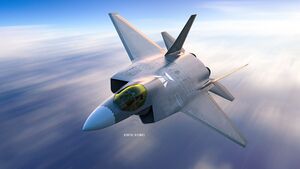Nikita GF-23 Vetala: Difference between revisions
| Line 39: | Line 39: | ||
===Airframe=== | ===Airframe=== | ||
Stressed ducts in s-shape are locked with airframe with the loaded bulkheads which are made of composite materials spanning the aircraft from air intake to engine shafts. The radome which holds radar is made of advance composite and construction, which result in allowing only the operating frequencies of the mated radar to transmit from the dome, while blocking other radars. | |||
===Flight surfaces and controls=== | ===Flight surfaces and controls=== | ||
===Propulsion=== | ===Propulsion=== | ||
Revision as of 07:32, 10 February 2021
| Nikita GF-23 Vetala | |
|---|---|

| |
| Role | Multirole fighter |
| Manufacturer | Nikita Corporation |
| Status | In active service |
| Primary user | Tennai |
| Program cost | NS$ 63 billion |
| Unit cost |
NS$ 45 million
|
The Nikita GF-23 Vetala is a Tennaiite single-seat, twin-engine, stealth all-weather multi-role fighter aircraft. It is produced by a public-private joint venture between the Defense Research and Development Organization, Nikita Corporation, Tennai Aerospace Industries, Cheppali International, and other private Tennaiite companies.
Nikita GF-23 Vetala can perform air superiority, ground attack, bombing, intercepting, strike and other types of roles. It combines supercruise, stealth, advanced AESA radar, supermaneuverability, data fusion and advanced avionics to overcome and suppress previous generation fighter aircraft along with many ground and maritime defenses. It complements the TAI GF-20 Berunda and the Cheppali GF-19 Garuda in the air force service and the GF-19 Garuda in the naval service. The aircraft, along with its naval variants, is intended to provide the bulk of the manned tactical air power of the Royal Tenniite Air Force and Navy over the coming decades.
Development
ASF Program
Funding
Design and development
Prototypes
Project mothballing and resumption
Modular approach
Design
Overview
The Vetala is a multirole fighter aircraft, with shoulder mounted diamond shaped trapezoidal wings, a profile with substantial area-ruling to reduce drag at transonic speeds, and an all-moving Canard-Vertical V-tail with large fuselage mounted Tail-wing. Flight control surfaces include leading and trailing-edge flaps, ailerons, rudders on the canted vertical stabilizers, and all-moving tailplanes; these surfaces also serve as Air brakes. The cockpit features a single seat configuration which is placed high, near the air intakes and wings of the aircraft to provide good visibility to the pilot with a single bubble canopy construction. The aircraft features a tricycle landing gear configuration with a nose landing gear leg and two main landing gear legs. The weapons bay is placed on the underside of the fuselage between the nose and main landing gear. The Vetala is designed to produce a very small radar cross-section, to accomplish this it features serpentine shaped air-intakes to reduce radar exposure to the fan blade which increases stealth, uses an internal weapons bay and features the use of composites and other materials. The flight control surfaces are controlled by a central management computer system. Raising the wing flaps and ailerons on one side and lowering them on the other provides roll.
A leading-edge root extension (LERX), which is a small fillet, is situated on the front section of the intake and wings of the aircraft. It has a typically roughly rectangular shape, running forward from the leading edge of the wing root to a point along the fuselage. Also, the Vetala has an In-flight refueling (IFR) probe that retracts beside the cockpit during normal operation.
The Vetala will be capable of operating in manned as well as in unmanned modes. According to the Royal Tennaiite Air Force chief Mandara Abira, the Vetala will have sixth generation characteristics added in the future.
Airframe
Stressed ducts in s-shape are locked with airframe with the loaded bulkheads which are made of composite materials spanning the aircraft from air intake to engine shafts. The radome which holds radar is made of advance composite and construction, which result in allowing only the operating frequencies of the mated radar to transmit from the dome, while blocking other radars.